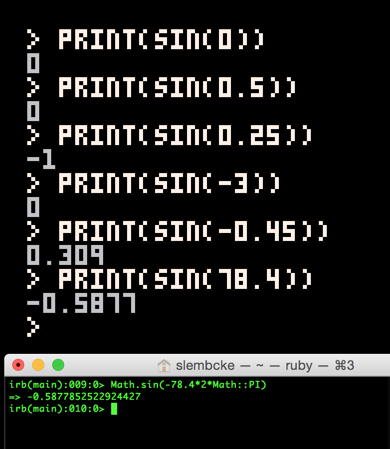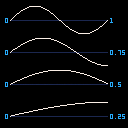Since PICO-8's sin(), cos() and atan2() are not the standard functions, how to implement them in another language? Some pseudocode would be ok, I'm aiming javascript by the way.
I looked into PicoLove's code as an example, but the results are different. For example in PICO-8:
print(sin(0)) -- 0 print(sin(0.5)) -- 0 print(sin(0.25)) -- -1 print(sin(-3)) -- 0 print(sin(-0.45)) -- 0.309 print(sin(78.4)) -- 0.5877 |
The PicoLove code remaps sin() to:
sin = function(x) return math.sin(-(x or 0)*(math.pi*2)) end |
that in javascript is:
window.sinp8 = function (x) { return Math.sin(-(x || 0) * (Math.PI * 2)); };
|
Now, the results are very different:
console.log(sinp8(0)); // -0
console.log(sinp8(0.5)); // -1.2246467991473532e-16
console.log(sinp8(0.25)); // -1
console.log(sinp8(-3)); // -7.347880794884119e-16
console.log(sinp8(-0.45)); // 0.3090169943749475
console.log(sinp8(78.4)); // 0.5877852522924427
|
Can you provide me with some working pseudocode for these three functions? Thanks

I think results of P8's sin is "normalized" i.e. made so it is within -1..1 range. Try normalizing your function and I think it should be close enough.

Looks correct to me except for the last value, which I suspect was copy pasted without the negative sign.


sin and cos of negative angles are the same as sin and cos of positive angles. always.
pico8 sin and cos take values from 0 to 1 instead of 0 to 2pi so if you want to implement it in an other language, just multiply the input angle by 2pi.
print(sin(0)) -- 0
print(sin(0.5)) -- 0 ... 0.5 on pico is the same as pi in math sin(pi)==0
print(sin(0.25)) -- -1 ... 0.25 on pico equals pi/2 in math.
print(sin(-3)) -- 0 ... -3 is the same as 0, 1, 2, 3 or -1, -2, -3 ... just 0 ... 1 is a full period (2*pi)
print(sin(-0.45)) -- 0.309 ... -0.45 is the same as 0.45
print(sin(78.4)) -- 0.5877 ... 78.4 is just 0.4
Here's a visualisation that might help:

pistacchio, in reality your results are not very different, and they are both correct.
when you see "-1.2246467991473532e-16" in javascript it's mean "-1.22(...) * 10 ^ -16", so "0.000000000000000122(...)", it's nearly 0.
the difference comes from the way that floats are stores in 32bits (https://en.wikipedia.org/wiki/Single-precision_floating-point_format).
Try a simple operation like "1.05 - 1" in javascript and the result will be "0.050000000000000044" instead of "0.05" :)
[Please log in to post a comment]












